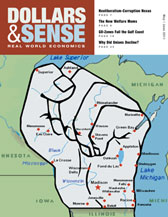This article is from Dollars & Sense: Real World Economics, available at http://www.dollarsandsense.org

This article is from the May/June 2011 issue of Dollars & Sense magazine.
Subscribe Now
at a 30% discount.
Comment
Teachers, Secretaries and Social Workers:
The New Welfare Moms?
Conservatives have had their sights on public-sector workers for a while and for good reason. Public-sector workers represent two favorite targets: organized labor and government. I am a public-sector employee and union member, so I can’t help but take these attacks and struggles personally. I am also a veteran of the welfare “reform” battles of the 1990s, and the debates over public-sector workers are strikingly similar.
Like welfare moms, public-sector workers have been painted as greedy [fill-in-the-blank barnyard animals], feeding from the public trough and targeted as the primary source of what’s wrong with government today.
Like 1990s welfare-reform debates, this one is dominated by more fiction than fact. For example, previous and recent research consistently shows public-sector workers actually earn less than private-sector workers with comparable skills and experience. While many, but not all, public-sector workers who work long enough for the public sector have a defined-benefit pension, the unfunded portions of those pensions are often due to bad state policy, not union negotiations.
In some states, like my own, Massachusetts, current workers are paying most of their pension costs through their own contributions into interest-bearing pension funds. Because state and local governments with defined pensions do not contribute to social security, there are currently cost savings. The upshot is that the cost of pensions may not be as high as some are arguing.
It is true that health-insurance costs for current retirees are expensive and worrisome. But this is because of the rising costs in private health insurance. Making workers pay more for their health-care benefits will erode the compensation base of public-sector workers, but it won’t get at the real problem of escalating health-care costs.
During the welfare debates, one of the arguments used to justify punitive legislative changes was spun around the fact that welfare moms who did get low-wage employment could also get child-care assistance—while other moms could not. Sound familiar? Public-sector workers do have employer-sponsored benefits many private-sector workers no longer get. But benefits haven’t improved in the public sector over the last 20 years; indeed most public-sector workers are paying more for the same benefits.
Over the same period, many private-sector workers have been stripped of their employer-provided benefits even as profits have soared. Instead of asking why corporate America is stripping middle-class workers of decent health-care coverage and retirement plans, the demand is to strip public-sector workers of theirs.
The new Cadillac-driving welfare queens are the handful of errant politicians who game the pension system and a few highly paid administrators getting handsome pensions. Sure they exist, but are hardly representative. The typical public-sector worker is a woman, most often working as a teacher, secretary or social worker. Women comprise 60% of all state and local workers (compared to their 47% representation in the private work force). And those three occupations make up 40% of the state and local work force.
Shaking down public-sector unions may make some feel better about solving government fiscal problems, but the end result will be more lousy jobs for educated and skilled workers. It will also not stem the red ink that is causing states to disinvest in much-needed human and physical infrastructure with budget cuts. But eroding wages and benefits combined with public-sector bashing will send a very loud market signal to the best and brightest currently thinking about becoming teachers, librarians, or social workers to do something else.
Wisconsin Governor Scott Walter is leading the attack on public-sector workers today. In the 1990s it was another Wisconsin governor, Tommy Thompson, who was a leader in demanding and implementing punitive changes to his state’s welfare system. His plan became a model for the rest of the states and federal welfare legislation in 1996. Then there were horror stories and welfare bashing, but not much in the way of discussing the real issue of decent paying jobs that poor and low-income mothers on and off welfare needed to support their families. The main result of welfare reform was the growth in working-poor moms.
There is one important difference. Public-sector workers, unlike welfare moms, have unions and a cadre of supporters behind them.
Did you find this article useful? Please consider supporting our work by donating or subscribing.
